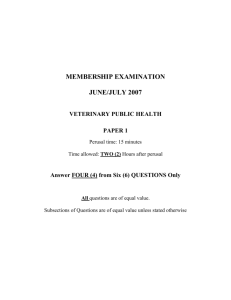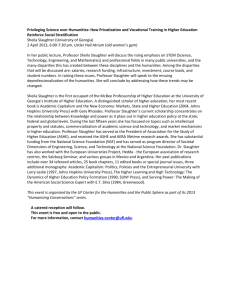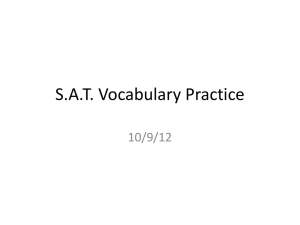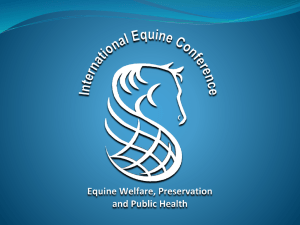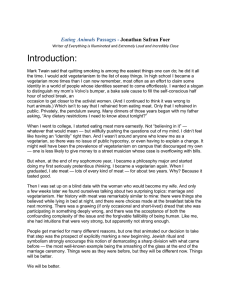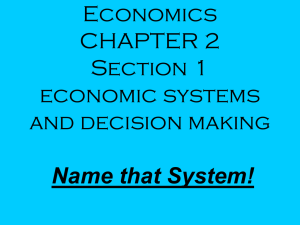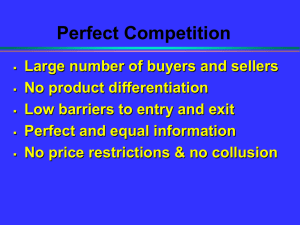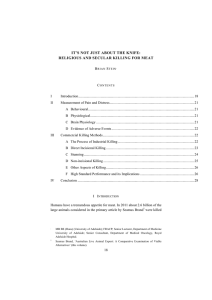Friend or Food? - Mechatronics
advertisement
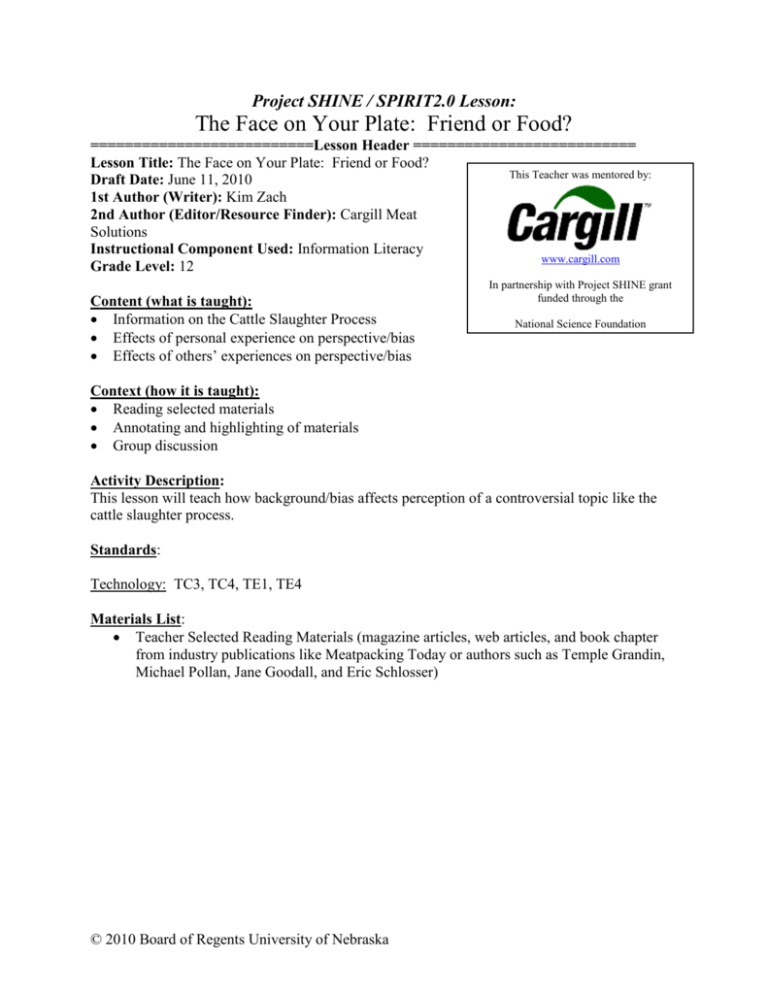
Project SHINE / SPIRIT2.0 Lesson: The Face on Your Plate: Friend or Food? ==========================Lesson Header ========================== Lesson Title: The Face on Your Plate: Friend or Food? This Teacher was mentored by: Draft Date: June 11, 2010 1st Author (Writer): Kim Zach 2nd Author (Editor/Resource Finder): Cargill Meat Solutions Instructional Component Used: Information Literacy www.cargill.com Grade Level: 12 Content (what is taught): Information on the Cattle Slaughter Process Effects of personal experience on perspective/bias Effects of others’ experiences on perspective/bias In partnership with Project SHINE grant funded through the National Science Foundation Context (how it is taught): Reading selected materials Annotating and highlighting of materials Group discussion Activity Description: This lesson will teach how background/bias affects perception of a controversial topic like the cattle slaughter process. Standards: Technology: TC3, TC4, TE1, TE4 Materials List: Teacher Selected Reading Materials (magazine articles, web articles, and book chapter from industry publications like Meatpacking Today or authors such as Temple Grandin, Michael Pollan, Jane Goodall, and Eric Schlosser) © 2010 Board of Regents University of Nebraska Asking Questions: (The Face on Your Plate: Friend or Food?) Summary: The questions will set up the lesson and get students thinking about what they already know about slaughter practices and how their own experiences/background may affect what they think of this practice (i.e. whether it is humane or inhumane). They will also consider how their background may affect their perceptions of the meat packing slaughter process. Outline: Students will reflect on their knowledge of the cattle slaughter industry Students will reflect on whether they have heard the practice referred to as humane or inhumane Students will consider examples where personal bias in writing or television has affected the message or the way the message is presented (such as commercials, magazine advertisements, non-fiction books, or in the newspaper) Students will consider whether their own background/experience will have an effect on their perception of the industry Activity: Students will answer the questions on a survey sheet first, then use their answers to engage in group discussion to explore the topic. Questions What do you know about the meat packing slaughter process for cattle? Have you ever heard anything about the process as being humane or inhuman? What is your background? (farm kid, animal lover, vegetarian, meat eater) How do you think this background may affect your perceptions of the meat packing industry? © 2010 Board of Regents University of Nebraska Answers Answers vary. Answers vary. Answers vary. Answers vary. Exploring Concepts: (The Face on Your Plate: Friend or Food?) Summary: Students will read selected articles, websites, and book chapters that represent both views of the cattle slaughter industry. Outline: Students will read selected articles from magazines and the web, as well as book chapters. Students will discuss the ideas they have read about in a large group setting. Activity: Teacher will hand out paper copies of the selected material for students. Students will read the material, and following completion of the reading, they will come together as a class for a large group discussion about the content of the articles. Resources: Teacher Selected Materials (suggestions listed below). Cargill Meat Solutions website (http://www.cargillmeatsolutions.com/) Industry publications such as Meating Place, Beef, and Meat & Poultry Harvest for Hope: A Guide to Mindful Eating by Jane Goodall The Face on Your Plate: The Truth About Food by Jeffrey Mousaaieff Masson The Omnivore’s Dilemma: A Natural History of Four Meals by Michael Pollan Fast Food Nation: The Dark Side of the All-American Meal by Eric Schlosser Humane Livestock Handling: Understanding Livestock Behavior and Building Facilities for Healthier Animals by Temple Grandin Move ‘Em: A Guide to Low Stress Animal Handling by Burt Smith Upton Sinclair’s “The Jungle”: A 100th Anniversary Retrospective http://www.towardfreedom.com/home/content/view/585/57/ © 2010 Board of Regents University of Nebraska Instructing Concepts: (The Face on Your Plate: Friend or Food?) Information Literacy Locating Information Information can be found in many different ways. It might be through traditional means like reading professional journals or going to the library or it could be through more technological means by searching the Internet using a search engine. Typically it will not be difficult to locate information rather the problem is finding relevant, reliable information. Organizing Information For the information that you locate to be useful it must be organized properly. There are many ways to organize data and ultimately you must pick the one that best works for you. In fact, the organizational method might change depending on what the information is. Some common organizational strategies for information are: data bases, word processing documents, spreadsheets, pocket mods, graphic organizers, mind maps, clustering, webbing, etc. Evaluate Information and Information Sources The evaluation of information is critical to using it properly. First, it must be relevant to the purpose intended and honestly presented. Second it must be deemed reliable. To do this you will want to consider the source of the information. Primary source information is a source that is closest to the thing being studied. These sources will be the most likely to be reliable. Secondary source information is a source where the information was originally presented somewhere else. It is best to use primary sources when possible. Synthesize Information Synthesizing information is the process where you take information previously known and combine it in a new way that provides new information and insights. This process is where new product is created. Ethically Use Information Ethical use of information is becoming a very important topic in society. Information should provide insight into what is going on in the world and it is important that it not be misrepresented or misused. Manipulation of information for the purpose of convincing an audience of a particular outcome is not desirable, ethical, and might be illegal. The information should stand on its own under scrutiny from experts as unbiased. Information that belongs to others must be cited otherwise plagiarism or copyright infringement is present. © 2010 Board of Regents University of Nebraska Organizing Learning: (The Face on Your Plate: Friend or Food?) Summary: Students will investigate the ideas of variety of perceptions of the cattle slaughter industry and consider the background of the author or originator of the information, and how that may affect the bias of their message. Outline: Students will read the selected material and highlight, underline, circle, write comments, and otherwise mark up the text Group discussion Activity: In this lesson, students will read a variety of selections about the cattle slaughter industry. They will also annotate the material as they read in order to increase understanding of the different views of the topic. After the annotation process a group discussion will take place regarding information literacy and how it applies to the articles. Special emphasis will be placed on organizing the information in like groups, evaluation of sources for bias, synthesis of the information and ethically reporting of information. Resources: Teacher Selected Materials (suggestions listed below). Cargill Meat Solutions website (http://www.cargillmeatsolutions.com/) Industry publications such as Meating Place, Beef, and Meat & Poultry Harvest for Hope: A Guide to Mindful Eating by Jane Goodall The Face on Your Plate: The Truth About Food by Jeffrey Mousaaieff Masson The Omnivore’s Dilemma: A Natural History of Four Meals by Michael Pollan Fast Food Nation: The Dark Side of the All-American Meal by Eric Schlosser Humane Livestock Handling: Understanding Livestock Behavior and Building Facilities for Healthier Animals by Temple Grandin Move ‘Em: A Guide to Low Stress Animal Handling by Burt Smith Upton Sinclair’s “The Jungle”: A 100th Anniversary Retrospective (http://www.towardfreedom.com/home/content/view/585/57/) © 2010 Board of Regents University of Nebraska Understanding Learning: (The Face on Your Plate: Friend or Food?) Summary: Students will write essays that summarize what they have read and discussed about the meat packing cattle slaughter process and how information literacy relates to the information they have read. Outline: Formative assessment of information literacy. Summative assessment of information literacy. Activity: Formative Assessment As students are engaged in the lesson ask these or similar questions: 1) How does the background of the author seem to reflect his/her perception? 2) What are the discrepancies in information about the same process? 3) Is the author ethical in the reporting of the information? Summative Assessment Students will write a formal essay that includes the following: 1) A summary of each selection and its viewpoint 2) The perception of each author and how it was affected by their background and whether the author used responsible information literacy. 3) The student’s personal view of the cattle slaughter process 4) Whether or not their own perceptions have shifted based on the reading and discussion © 2010 Board of Regents University of Nebraska
